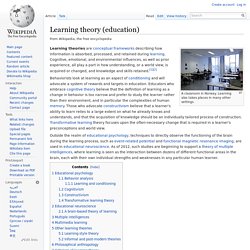

When you write your rationale. Learning theory (education) A classroom in Norway.

Learning also takes places in many other settings. Learning theories are conceptual frameworks describing how information is absorbed, processed, and retained during learning. Cognitive, emotional, and environmental influences, as well as prior experience, all play a part in how understanding, or a world view, is acquired or changed, and knowledge and skills retained.[1][2] Main article: Behaviorism The term "behaviorism" was coined by John Watson (1878–1959). Methodological behaviorism is based on the theory of treating public events, or observable behavior.
In behavior analysis, learning is the acquisition of a new behavior through conditioning and social learning. There are two types of conditioning and learning: Classical conditioning was noticed by Ivan Pavlov when he saw that if dogs come to associate the delivery of food with a white lab coat or with the ringing of a bell, they will produce saliva, even when there is no sight or smell of food. Education Theory/Constructivism and Social Constructivism - UCD - CTAG.
"Constructivism is the philosophical and scientific position that knowledge arises through a process of active construction.

"(Mascolol & Fischer, 2005) "As long as there were people asking each other questions, we have had constructivist classrooms. Constructivism, the study of learning, is about how we all make sense of our world, and that really hasn’t changed. "(Brooks, 1999) Background Constructivism and Social Constructivism are two similar learning theories which share a large number of underlying assumptions, and an interpretive epistemological position. Underlying Assumptions Jonassen (1994) proposed that there are eight characteristics that underline the constructivist learning environments and are applicable to both perspectives: Constructivist learning environments provide multiple representations of reality. Epistemology The default epistemology in education is an empirical/reductionist approach to teaching and learning. Learning theories map. The following ‘learning theories map’ has been created as a result of the work performed in the HoTEL project (EU Support Action).
Please click on the map to access an interactive version of the map. “Learning theory has been a contested scientific field for most of its history, with conflicting contributions from many scientific disciplines, practice and policy positions. Howard Gardner's Multiple Intelligences. Howard Gardner theorized that there are multiple intelligences, and that we all use one or two for the most effective learning.

Our culture teaches, tests, reinforces and rewards primarily two kinds of intelligence: verbal/linguistic and logical/mathematical. His theory proposes that there are at least eight other kinds of intelligence that are equally important. They are “languages” that most people speak, and that cut through cultural, educational, and ability differences. The mind is not comprised of a single representation or a single language of representations. Rather, we harbor numerous internal representations in our minds. The Powerful, Rich efolio experience. Recently I received an e-mail from someone working to justify efolios for preservice teachers at a college.

Here was an excerpt of the letter: "Thank you for writing me back...I did write an introduction to the manual which lists the student benefits of creating an online portfolio. My professor has been trying to convince all instructors of ... [removed to protect privacy] how they can also benefit by having their students create online portfolios. I would like to list in my introduction, instructor benefits as well because I am sure that there will be some who see my manual. I had a quick response as follows. "I believe efolios are beneficial for the following reasons:It provides a central repository for collecting the digital artifacts that are samples of student work in one location.
But I knew someone who knows so much more about e-folios than I. So, I asked my friend Dr. Such meaningful dialog couldn't be wasted on my inbox. Dr. Helen Barrett's Electronic Portfolios. Education Technology Magazine. Funderstanding: Education, Curriculum and Learning Resources. Jason ohler : Wisdom Lists - Education, kids, technology. Part I.

Education researchers, theorists Part II. Education practicioners, prognosticators Benjamin Bloom Prepared by Donald Clark, Copyright 1999 (found @ - Top of page By Larry Cuban Is the machine or software program simple enough for me to learn quickly? By Howard Gardner THE ORIGINAL SEVEN INTELLIGENCES Howard Gardner identified and introduced us to seven different kinds of intelligence in Frames of Mind. Linguistic intelligence: a sensitivity to the meaning and order of words. Gardner discussed the "eighth intelligence" with Kathy Checkley, in an interview for Educational Leadership. "The naturalist intelligence refers to the ability to recognize and classify plants, minerals, and animals, including rocks and grass and all variety of flora and fauna. Gardner identified Charles Darwin as a prime example of this type of intelligence.
And the naturalist intelligence met Gardner's specific criteria: * "Is there a particular representation in the brain for the ability? LEVEL A. Stage 1. I. Mf_ltreport.pdf. Educational Learning Theories.